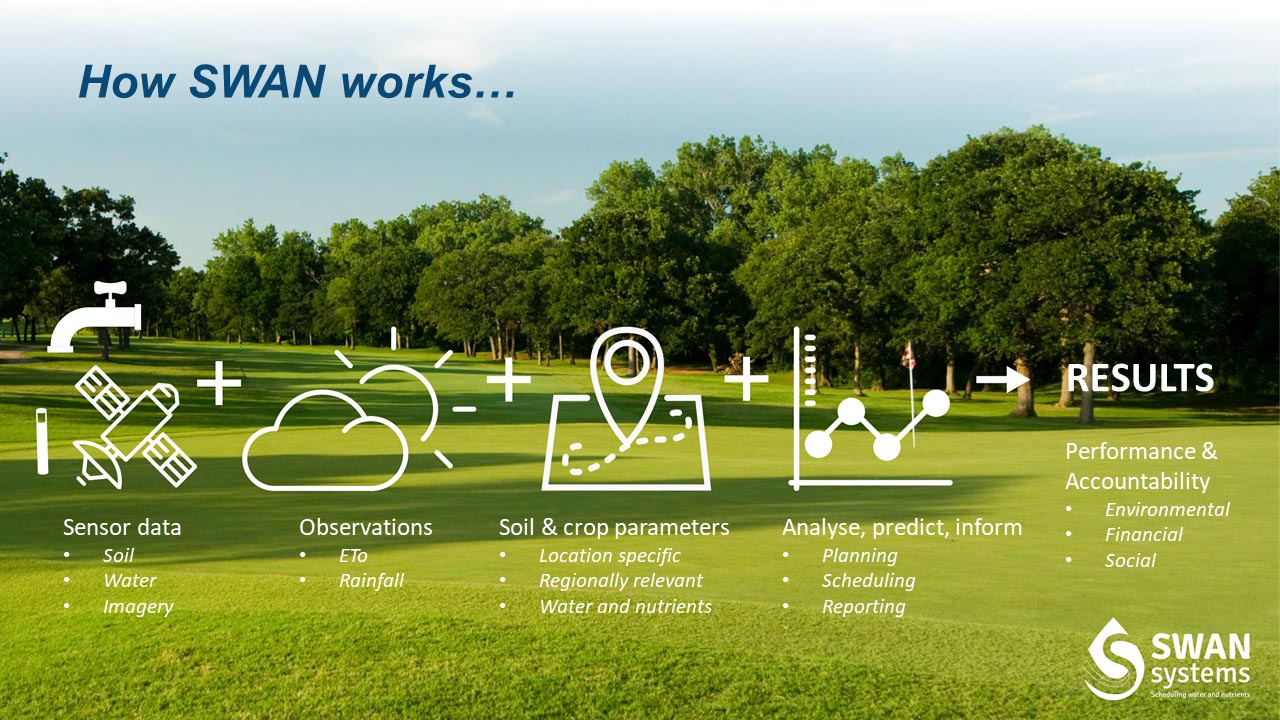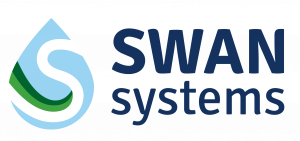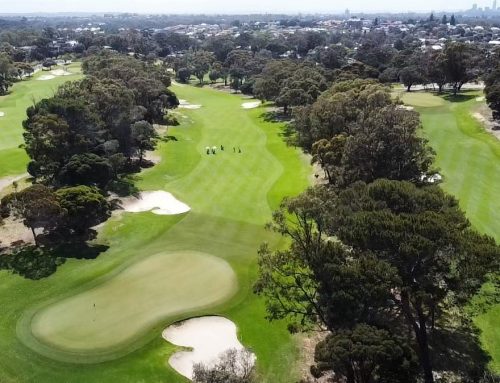SWAN Systems & the City of South Perth
Article appeared on The Overflow by Irrigation Australia, Spring 2017 Edition
Turning data into information for optimal irrigation

Public open space managers are increasingly becoming curators of significant data resources. These data include weather observations and forecasts, water use (flow meter readings), soil moisture data, water analysis, and nutrient application records. All must be considered and utilised in the site-specific design and management of irrigation and nutrient plans. Frequently these disparate forms of data are recorded ad hoc and/or housed in scattered locations (including the backs of envelopes!). This situation puts considerable time and administrative pressure on managers and ground staff to interpret and act on a large amount of information in a timely and accountable way.
Automated data collection potentially saves time and a number of services provide automatically logged data of the types listed above. However, users of the data must visit numerous data repositories and are largely left to their own devices for interpretation and analysis before management decisions can be made.
SWAN is third party certified as a water efficient service under the Smart Approved WaterMark scheme and is also a Waterwise endorsed service, providing assurance that SWAN’s use will reinforce good reputations in water management.
SWAN Systems is a WA-based irrigation technology business specialising in precision water and nutrient management. SWAN (for Scheduling Water and Nutrients), our online software service, automatically collects local daily weather observations from the Bureau of Meteorology (BoM), DPIRD and other sources, and data from on-site equipment such as flow meters, controllers and soil moisture probes. SWAN analyses each weather update and irrigation event to provide a daily monitoring of soil moisture status along with a snapshot of each site’s water usage. This allows continuous tracking of site irrigation status and of budgeted versus actual applications.
Critically, SWAN also looks forward, using BoM’s gridded models to provide highly local weather forecasts for each site. With automatic daily updates of forecast evapotranspiration and rainfall, and planned irrigation applications, SWAN uses crop- and soil-specific models to predict future water use and soil moisture status. This provides irrigators with effective insights to make daily, weekly and seasonal water and nutrient management decisions. SWAN thus allows dynamic
management to ensure provision of the right amount of water and nutrients for plant growth given recent management, weather history, and the immediate forecast.
CUSTOMISABLE, POWERFUL MANAGEMENT TOOL
SWAN’s flexibility is key. It is hardware-agnostic, and can be adapted for use with existing infrastructure and data loggers. It can also accept data via manual input. The models employed by SWAN can be customised for almost any crop, soil type, or management priorities. Flexible configuration and always upto-date
data collection help to avoid the common practice of rigid (‘set and forget’) applications that are based on climate data obtained from ‘average years’. The interface is designed or convenience and ease of interpretation and, importantly, rapid review of many sites.
SWAN’s capabilities also include a seasonal water budgeting and allocation module and nutrient planning and tracking. The platform is scalable to cover as many sites as required as long as minimum telemetry and data requirements are met.
CHALLENGES FOR LOCAL GOVERNMENTS AND PARK MANAGERS
The climate across Australia has changed dramatically in recent years, with warming and drying trends evident in major population corridors. For example, analysis of climate trends for the south west of WA show a significant drop in rainfall (and a lack of very wet years) from the mid 1970’s to present, while temperatures, which affect evaporation and therefore plant water needs, have increased, with the period 2011 to 2015 the hottest five years on record. These changes combined with urban growth have resulted in increasing pressure on decreasing groundwater resources.

“Brown parks are not an option for the future of my Perth. We are advocating for smarter ways to ensure adequate water is available for these vital living green areas.”
Long term climate averages are often not a reliable source for predicting future irrigation requirements.
Water for irrigation is crucial for public open space or sporting fields. Local governments are under increasing pressure to maintain the social amenity of public open space and meet demands for ‘fit-for-purpose’ public open space parks, which are linked firmly with public health outcomes (as embedded in the Public Health Act 2016).
Park managers in the Perth metropolitan area have their annual groundwater allocations capped at 7500 kL per hectare (and at 6750 kL in Perth’s northern corridor where the Gnangara mound is under major stress). These allocations are currently under review and are likely to be revised downwards in direct response to warming and drying trends. Community concerns regarding the watering of these areas also need to be considered, including perceived waste, an issue that has shown up in the Water Corporation’s 2017 ‘TapIn’ Community Survey.
Innovation, precision management, accountability and information to inform difficult choices will be required to meet these challenges. SWAN’s capabilities are designed with these challenges in mind.
PILOT STUDY: CITY OF SOUTH PERTH
Together with Sports Turf Technology and the City of South Perth we are conducting a pilot project to evaluate the benefits of adopting SWAN. Two sites will be tested – the poorly drained Sir James Mitchell Park on the South Perth foreshore and a sandy well drained sports field on the eastern section of the Collier Park Reserve.
Although currently meeting licence conditions, the City of South Perth recognises that significant reductions to groundwater allocations are inevitable as a result of future policy changes, climate change and groundwater decline. Identifying potential water savings now is important to help seasonal water budgeting and allocation or reallocation decisions across all their parks.
The City is in the process of upgrading its Aquamonix central control system and this has included an arrangement with Aquamonix for SWAN Systems to access flow data directly from the system. Richard Bryant and Chris Simondson, South Perth’s parks supervisors, were happy to support this initiative to provide an integrated product that would further support the sustainability of public open space management.
Independent soil moisture probes have been installed and weather forecasts and observations are being collected from the nearest BoM and DPIRD stations. These data feeds are already being utilised by SWAN’s cloud-based analytics to communicate user-friendly information to guide best practice water use. Of importance to South Perth is to see how SWAN will impact on run times and efficiency, and therefore water use, compared to their current fixed run times of three irrigations per week.
The nutrient module of SWAN is also important to the City’s parks management. Sir James Mitchell Park is located on the South Perth Foreshore, which is within the Swan River Trust’s ‘Development Control Area’. The City of South Perth is currently responsible for managing the foreshore, which includes ensuring
phosphorus and nitrogen runoff into the river is minimised. Certainty that both water and nutrient use efficiencies are maximised is critical to meeting this responsibility.
OUTCOMES
In a following issue we will report on the outcomes of this and other pilots and provide further details on SWAN’s nutrient tracking and remote plant health sensing features.
Like it or not, data is here to stay and the ability to deal with it for maximum benefit will be telling. SWAN can integrate with existing irrigation and sensor equipment and will help users in all sectors of the irrigation industry to improve benefits from the use of their data. SWAN’s outputs are site specific and will
ensure optimum plant condition while saving water and costs in terms of energy, fertiliser, and operational and management staff time.
Article republished with permission from Irrigation Australia. Original article posted on https://www.irrigationaustralia.com.au/documents/item/600. Free download of The Overflow Spring 2017 Edition available here.





